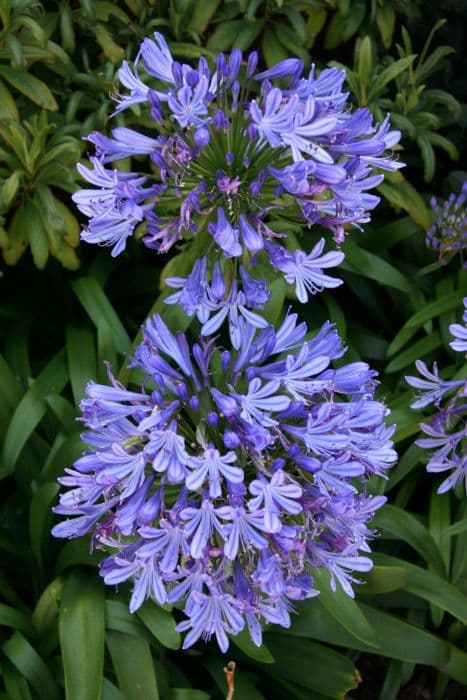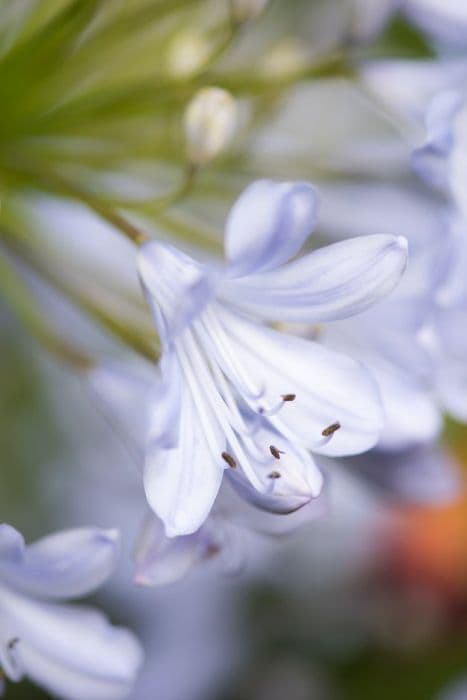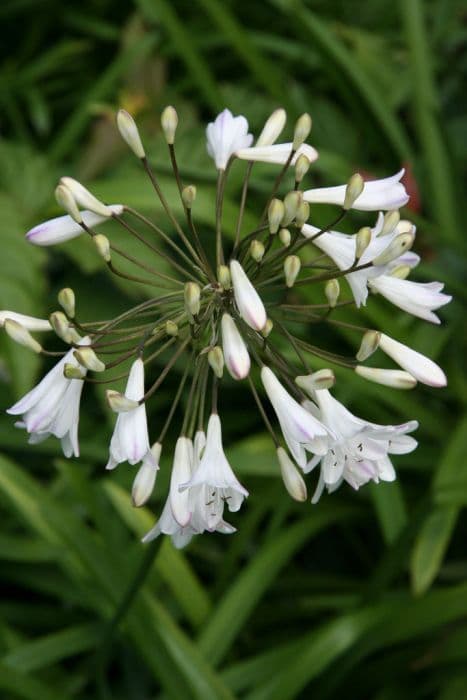African Lily Agapanthus africanus 'Albus'

ABOUT
Agapanthus africanus 'Albus', commonly known as the White African Lily, is an ornamental plant noted for its striking and elegant appearance. The White African Lily showcases lush, strap-like, green leaves that form a dense clump, creating a verdant base for its remarkable floral display. The leaves maintain a sleek, glossy appearance that provides a beautiful contrast to the flowers. The most distinctive feature of the White African Lily is its spectacular blooms. They emerge on strong, upright stalks, giving rise to umbrella-like clusters of pure white flowers. These flower clusters, known as umbels, are composed of several trumpet-shaped florets that open from the buds in succession, creating a prolonged display of blossoms. The delicate florets have a gentle beauty, with a subtle grace radiating from their simple yet sophisticated shape. The flowers of the White African Lily are particularly attractive to a variety of pollinators, adding an ecological value to its aesthetic appeal. When in full bloom, the plant can become a focal point in the garden, captivating onlookers with its serene white blossoms that seem to float above the green foliage like ethereal globes. The overall impression is one of classic elegance, making the White African Lily a favored choice for both formal and informal garden settings.
About this plant
 Names
NamesFamily
Amaryllidaceae.
Synonyms
African Lily, White African Lily, White Lily of the Nile, White Love Flower, Snowy African Lily.
Common names
Agapanthus africanus 'Albus'.
 Toxicity
ToxicityTo humans
Lily of the Nile (Agapanthus africanus 'Albus') contains compounds which can be toxic to humans. Ingesting any part of the plant, especially the roots and sap, can result in symptoms such as nausea, vomiting, abdominal pain, and diarrhea. In some cases, skin contact with the sap may cause irritation or allergic dermatitis. It is important to handle this plant with care and ensure that children do not ingest any part of it.
To pets
Lily of the Nile (Agapanthus africanus 'Albus') is also toxic to pets. If ingested, the plant can cause symptoms such as nausea, vomiting, and diarrhea. In more severe cases, it might lead to drooling, lethargy, or tremors. The roots and sap contain the highest concentration of toxic substances, although all parts of the plant can be harmful if consumed. Pet owners should keep their animals away from this plant to prevent accidental ingestion.
 Characteristics
CharacteristicsLife cycle
Perennials
Foliage type
Evergreen
Color of leaves
Green
Flower color
White
Height
2.6 feet [80 cm]
Spread
2 feet [60 cm]
Plant type
Herbaceous
Hardiness zones
8
Native area
South Africa
Benefits
 General Benefits
General Benefits- Ornamental Appeal: The Agapanthus africanus 'Albus', commonly known as White African Lily, is valued for its large, round clusters of white, bell-shaped flowers, which add a striking ornamental feature to gardens.
- Landscape Design: White African Lily can be used as a border plant, in mixed beds, or in container gardens, providing versatility in landscape design.
- Drought Tolerance: Once established, this plant is relatively drought tolerant, making it suitable for xeriscaping or gardens with low water availability.
- Wildlife Attraction: The showy blooms are attractive to pollinators like bees and butterflies, enhancing the biodiversity of the garden.
- Low Maintenance: White African Lily generally requires minimal care beyond the initial establishment period, making it a good choice for gardeners seeking low-maintenance plants.
- Long Bloom Season: With a blooming period that extends through the summer, this plant provides a long-lasting display of flowers in the garden.
 Medical Properties
Medical PropertiesThis plant is not used for medical purposes.
 Air-purifying Qualities
Air-purifying QualitiesThis plant is not specifically known for air purifying qualities.
 Other Uses
Other Uses- Agapanthus africanus 'Albus', commonly known as white African lily, can be used as a source of blue or green dye for fabrics, thanks to its pigmented petals.
- The flower's sturdy, long stems are valued for use in floral arts, particularly in creating elegant and dramatic flower arrangements.
- White African lily's leaves can be woven into baskets or mats due to their length and fibrous nature.
- The sap from the white African lily has been traditionally used as a glue or adhesive in some cultures.
- The flowers are sometime used in educational settings for botanical studies due to their distinct and easily observable structure.
- Seed pods from the white African lily may be used in ornamental crafts or as natural rattles when dried.
- Petals of the white African lily can be pressed and used in the creation of natural bookmarks or incorporated into papermaking for decorative effect.
- The striking appearance of white African lily makes it a popular choice for photography subjects and botanical illustration.
- Its root system can be utilized in soil erosion control, as it helps in stabilizing banks and slopes.
- In the language of flowers, white African lily is often used to express love letters and romantic gestures, being a symbol of love and appreciation.
Interesting Facts
 Feng Shui
Feng ShuiThe Lily of the Nile is not used in Feng Shui practice.
 Zodiac Sign Compitability
Zodiac Sign CompitabilityThe Lily of the Nile is not used in astrology practice.
 Plant Symbolism
Plant Symbolism- Love Letters: The name Agapanthus comes from the Greek words 'agape', meaning love, and 'anthos', meaning flower. This white cultivar of Agapanthus, therefore, symbolizes a love letter or message.
- Purity and Innocence: The color white is often associated with purity and innocence, and Agapanthus africanus 'Albus', with its white flowers, can symbolize these qualities.
- Beauty: With its striking blooms, the plant is often connected to the idea of beauty and appreciation of beautiful things.
- Loneliness or Solitude: In some interpretations, Agapanthus can represent solitude due to its individual, statuesque flowers.
- Enduring Love: The robustness and perennial nature of Agapanthus can symbolize enduring or long-lasting love.
 Water
WaterLily of the Nile should be watered deeply once a week, making sure the soil is thoroughly moistened. During the growing season in spring and summer, you may need to water more frequently, especially if the weather is particularly hot or dry. Aim for about 1-2 gallons of water per plant for each watering session, depending on the size of the plant and the environmental conditions. Reduce watering in the fall and further in winter when the plant is dormant. Always check the top inch of soil for dryness before watering to prevent overwatering.
 Light
LightLily of the Nile prefers full sun to partial shade. The ideal location would provide at least 6 hours of direct sunlight daily, but the plant can tolerate some shade, especially in hotter climates. A spot that receives morning sunlight and partial afternoon shade is optimal to protect the foliage and blooms from intense midday heat.
 Temperature
TemperatureLily of the Nile thrives in temperatures between 50°F and 80°F, making it suitable for outdoor growth in USDA zones 8 through 10. It can survive minimum temperatures down to about 20°F but should be protected from sustained freezes. The plant performs best when nighttime temperatures don't drop below 50°F.
 Pruning
PruningPrune Lily of the Nile to remove spent flower stalks and rejuvenate the plant. After blooming, typically in late summer or early fall, cut back the flower stalks to the base. Additionally, remove any damaged or discolored leaves to maintain the plant's appearance and health. Pruning is also an opportunity to divide overcrowded clumps every 3-4 years to propagate new plants.
 Cleaning
CleaningAs needed
 Soil
SoilThe African Lily, or Agapanthus africanus 'Albus', thrives best in a soil mix that is well-draining, yet retains moisture, such as a loam-based potting mix with added perlite or sand for increased drainage. The ideal pH for African Lily soil should be slightly acidic to neutral, ranging from 6.0 to 7.0.
 Repotting
RepottingThe African Lily should be repotted every 2 to 4 years, as they prefer to be slightly root-bound. It's best to repot in spring before new growth begins.
 Humidity & Misting
Humidity & MistingAfrican Lily prefers moderate humidity conditions but is quite adaptable and can tolerate the humidity levels typically found in most homes.
 Suitable locations
Suitable locationsIndoor
Place in bright, indirect light.
Outdoor
Full sun to partial shade, shelter from strong winds.
Hardiness zone
8-11 USDA
 Life cycle
Life cycleThe life of Agapanthus africanus 'Albus', commonly known as White African Lily, begins with seed germination, which occurs in warm, moist soil conditions in spring or early summer. The seedlings develop into juvenile plants with strap-like leaves, and they gradually form a clump as they grow. In the following years, the clump expands and the plant matures, developing long, fleshy roots and larger leaves. The most distinctive phase is the flowering stage, which typically occurs in the summer, when the White African Lily produces tall stalks topped with umbels of trumpet-shaped, white flowers. After flowering, the plant sets seed, which can be collected for propagation or allowed to fall and potentially germinate nearby. During fall and winter, the plant enters a period of dormancy, especially in cooler climates, where the foliage may die back until the warmth of spring stimulates new growth.
 Propogation
PropogationPropogation time
Spring to Summer
Propogation: The most popular method of propagating Agapanthus africanus 'Albus', commonly known as the white African lily, is by division. This method is best performed in the spring just before the plant begins its active growth phase. To propagate by division, carefully lift the entire plant out of the ground with a shovel, taking care not to damage the roots. Using a sharp knife or spade, divide the clump into smaller sections, ensuring that each section has at least one or two developing shoots and a portion of the root system. Replant the sections at the same depth they were originally growing, spacing them about 18 inches (approximately 45 centimeters) apart to allow for growth and good air circulation. Water the newly planted divisions thoroughly to help establish them. This technique is favored as it maintains the specific characteristics of 'Albus' and ensures a quicker establishment compared to starting from seeds.



![African lily [Blue Storm]](/_next/image?url=https%3A%2F%2Fplants-admin.emdemapps.com%2Fimages%2Fplants%2F%2Fimages%2F604b63200a08b.png&w=640&q=75)





